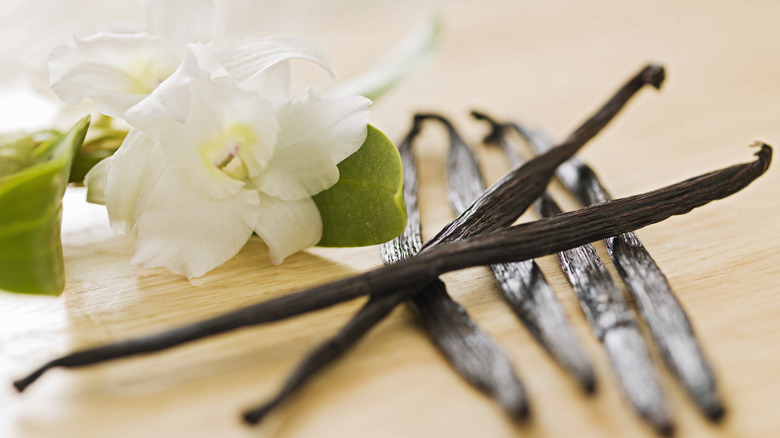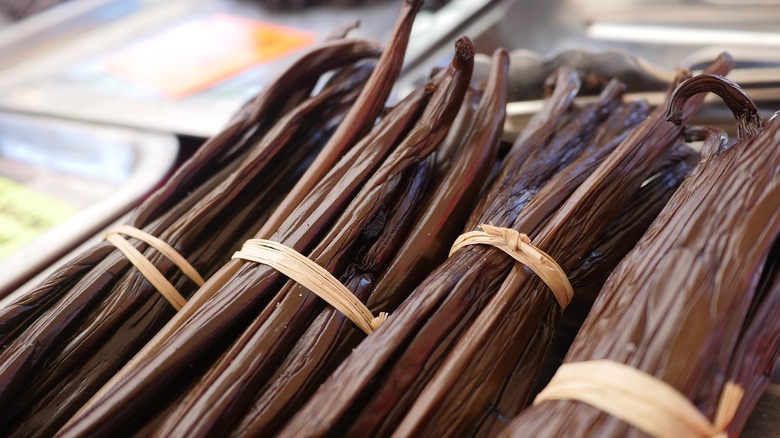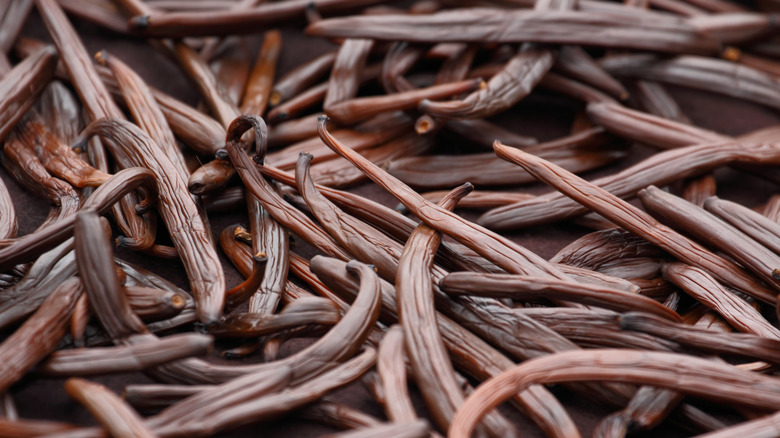How Long Do Whole Vanilla Beans Last?
Warm, floral, and downright delicious, the many types of vanilla you can buy all provide an irreplaceable flavor and aroma to baked goods and other desserts. You might be most familiar with it in extract form, but all vanilla is derived from pods that sprout from a species of tropical orchid. Whole, dried vanilla beans are considered the pinnacle of vanilla by many a pastry chef and sweets lover, offering a stronger, more complex, fresher taste than an extract (or worse, imitation vanilla extract).
The downside is that your expensive and delicious vanilla beans will eventually expire, and far more quickly than a bottled extract. How long do they last before they go south? Luckily, whole vanilla beans can last for up to a year when properly stored. Although it might be tempting to use them past their expiration date — the good stuff costs a pretty penny, after all — their aroma and taste will dwindle as time passes, eliminating their ability to add that special touch to your favorite dishes.
Even more importantly, vanilla beans are also prone to mold development. This might be a surprise, since they go through a long drying process before they're sold, and don't seem as susceptible to mold as, say, fresh produce. But these beans are the freshest form of vanilla on the mainstream market, so you bet that they can eventually rot and mold, with enough time.
How to properly store vanilla beans
Although they can last for up to a year, vanilla beans can go bad much faster if they're not properly stored. The pods are as delicious and useful as they are delicate, so proper storage is a must to keep their precious flavors and aromas intact. Unless you plan to use them as a potpourri, store vanilla beans in an airtight container to prevent exposure to oxygen, which can accelerate the degradation process.
Before you place the beans in the container of your choice, consider wrapping them in wax paper to keep them nice and moist. They are dried out after being picked, but preserving their remaining moisture is key to keeping them fresh, plump, and flavorful. You don't want to discover a bunch of dry and shriveled beans when you're in the middle of making a vanilla buttermilk cake.
As for where to store the beans, keep them in a cool, dark place, such as a pantry or a cupboard. Vanilla beans shouldn't be exposed to temperatures lower than 65 degrees or higher than 85 degrees Fahrenheit for more than a few minutes. Finally, label your container of vanilla beans with the date they were purchased and the date they were stored in your pantry. This is the easiest way to keep track of their lifespan.
How to tell if vanilla beans are spoiled
Now that you know how long they last and the best practices for storage, the final part of using vanilla beans wisely lies in recognizing signs of spoilage. For starters, vanilla beans often develop small "crystals" on the outside, but you shouldn't be alarmed if your pods are studded with transparent little gems. Vanilla crystals are bursting with flavor and aroma, and are actually signs of high-quality beans. Though you might mistake the crystals for mold, don't confuse the two — mold is fuzzier and can take on green, grey, and purple hues. If you see actual spores, ditch the beans. Salvaging them isn't worth finding out what happens when you eat mold.
Also, vanilla beans are naturally moist, but if they take on a snotty, slimy, wet consistency, they've gone bad and need replacing. Scent can also tell you a lot about vanilla pods. You should remember how amazing the beans smelled when they were fresh, so if you sniff them and notice any rancid, unusual, or particularly pungent odors, that's another surefire sign that the vanilla has soured. Whole vanilla beans are a prized spice that deserve a spot in your kitchen, so take the proper steps to ensure they last as long as they can. Long live your vanilla beans!


